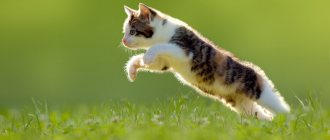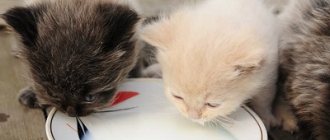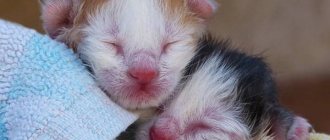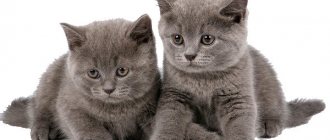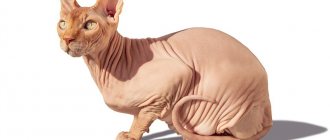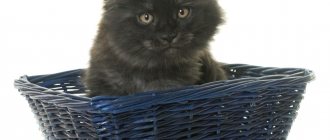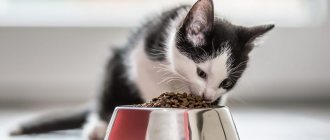Weight gain in the first year of a cat's life is uneven. The most rapid growth occurs in the first month after birth: during this period, the kitten can gain up to 15 grams per day. A calm and sedentary pace of life contributes to this. When kittens are one month old, they weigh on average 450-500 grams.
Closer to 2 months, solid food, which contains more protein, is introduced into the kitten’s diet. At this time, kittens become active and playful. Calories are burned faster and the rate of weight gain slows down. At two months of age, kittens can weigh up to one and a half kilograms.
At 3 months, the gender of the kitten will significantly influence how much it should weigh. By the third month, gender begins to influence the difference in weight more strongly. The kitten will continue to gain weight until it is five months old, and by the time it is six months old, the females will have fully formed. Males may continue to gain slight muscle mass, causing their weight to increase. To understand whether a kitten's weight is appropriate for its age, it is important to consider its breed.
Kittens gain weight fastest in the first week of life.
Weight of kittens depending on the number in the litter
The larger the litter, the greater the likelihood that among the kittens there will be weak babies.
The more kittens, the less milk the cat has
The number of newborn kittens also affects their weight gain in the first months of life. At the same time, a cat can fully feed up to 6 kittens. If more were born, someone will inevitably be malnourished. The most agile brothers and sisters will occupy the mother cat's nipples, not allowing the weak kittens to fully feed. If the kitten constantly squeaks, cannot get close to the nipple, or is pushed away by other kittens, feed the baby additionally with a special mixture.
When furry pets open their eyes
You can quite accurately determine how old a kitten is by examining its eyes. Kittens are born blind and usually open their eyes on the tenth to twelfth day, but not earlier than a week after birth. In healthy kittens up to two weeks old, the eyelids are tightly closed or slightly open, and there is no opaque discharge. At the same time, the eyes will remain cloudy and bright blue for some time, and only then will they begin to change their color to “adult” - unless the breed of cat assumes that they will remain blue-eyed (Angora, Siamese, British and others). Blue eyes mean that the kitten is not yet two and a half months old. Typically, the eye color of cats is green or yellow, sometimes amber. The color is finally established by the age of six months. You can also look at the babies' ears. At birth, kittens' ears are pressed tightly against their head, as kittens are born with closed ear canals. They open no earlier than the fifth day of life, and the kittens begin to hear; The ears lift completely in the second or third week.
Newborn kitten
How much should a cat weigh at different stages?
If the kitten is well fed, healthy and developing normally, its weight will increase rapidly in the first weeks of life. It is important to weigh the kitten daily in the first month, when its body is especially vulnerable. Let's look at the average weight at different stages of a cat's life.
- Birth and first week of life. Depending on the breed, a newborn kitten weighs from 70 to 130 grams.
- Second week. During this period, kittens grow very quickly; their normal weight ranges from 110 to 250 grams.
- Third week. If the kitten develops normally and receives enough nutrition, its weight ranges from 210 to 420 grams.
- Fourth week. By 4 weeks the baby weighs from 250 to 500 grams.
- At two months of age, kittens weigh from 1 to 1.5 kilograms.
- By the third month, weight can range from 1.5 to 2.3 kilograms.
- At 5 months, the normal weight of a cat is from 2.3 to 4.2 kilograms.
- A six-month-old kitten can weigh from 2.5 to 4.8 kilograms. The exact weight norm depends on the breed and gender of the baby.
Diet
Having chosen a certain method of nutrition, do not deviate from it, otherwise it will threaten unpredictable consequences for the baby’s fragile body. It is prohibited to combine two feeding methods - eating natural food and ready-made cat food.
Veterinarians explain this by saying:
- wards will have digestive problems leading to gastrointestinal diseases;
- An overdose of vitamins in an animal can lead to hypervitaminosis.
Natural nutrition
After the change of milk teeth, the diet of a growing 3-4 month old kitten must include solid food rich in protein. It is recommended to diversify dairy products whenever possible. Veterinarians also advise adding vegetables rich in various vitamins to your food. Meat components should be included in the pet's diet in overwhelming quantities, and cereals and vegetables can make up less than half of the daily portion of food. You can’t completely stop your kitten from eating meat: the taurine it contains is very important for heart and eye health.
Veterinary experts advise including the following natural products in the diet of a 3-4 month old kitten:
- It is mandatory for the kitten to consume boiled lean meat - primarily beef, as well as chicken fillet or turkey meat in small chopped pieces or in the form of minced meat (if there is a confirmed absence of worms, from the age of three months it is also allowed to give raw frozen meat, tested for quality);
- low-fat milk and fermented milk products without additives - kefir, fermented baked milk, etc.;
- low-fat cottage cheese, necessary for strengthening teeth and bones (initially it is better to start by consuming a ready-made liquid product, for example, Agusha brand cottage cheese, which has proven itself well);
- various vegetables - pumpkin, zucchini, cabbage - in chopped form (raw grated ones are best, but if the kitten refuses to eat them in their pure form, you can mix vegetable mixtures into porridge or boil cereals in vegetable broth);
- raw or boiled and chopped egg yolk;
- lean fish without bones (preferably sea fish, because a river pet can easily become infected with worms);
- cereal dishes - porridge with water, milk, vegetable and meat broth (the cat's body accepts semolina and rice best);
- special grass that is useful for cats (you can grow it yourself on the windowsill, or buy sprouted oat or wheat sprouts at a pet store or veterinary pharmacy);
- vegetable oil in small quantities to improve digestion.
What should you not feed?
It is recommended to completely exclude a three-month-old kitten from the diet:
- fatty foods that will only harm the stomach and liver (in particular pork - meat, lard, fat);
- meat with bones (a kitten can choke on hollow bones or scratch the stomach walls);
- whole cow's milk;
- salted and spiced food (often, in an effort to make food more attractive, breeders rely on their own taste and make it completely unsuitable and dangerous for a small, fragile organism);
- spicy and canned food (sausages, canned food from your table);
- fried foods (can clog the intestines with toxins);
- tomatoes and eggplants;
- corn and cereals from it;
- any sweets, especially chocolate (eating them weakens the immune system, causes dental disease and hair loss).
It is better to limit the consumption of some foods to a minimum, these are:
- oat and bean cereals;
- River fish;
- potatoes in any form (cats are almost unable to digest starch).
During the period of illness, some foods are also excluded from the diet: for diarrhea - fermented milk, for constipation - solid foods containing carbohydrates and starch in the required amount. In addition, the “cat owner” needs to be very careful and keep vitamins and medicines intended for people out of the kitten’s reach, otherwise, if he tries them, he may get seriously poisoned.
How often and in what quantity per week you can give your pet basic foods is up to each owner to decide individually, but the main recommendations are as follows:
| Daily | Once every 2 days | in 7 days |
| beef (30-80 grams) | vegetable oil (0.5 tsp) | 3-4 times every 7 days: chicken fillet or minced meat: (50-120 grams) |
| milk and fermented milk products without fruit additives (100 grams each) | 2-3 times every 7 days: vegetable puree or porridge with added vegetables (20-30 grams of vegetables) | |
| 1-2 times every 7 days: raw chicken egg yolk (1 pc.) | ||
| cereals and cereals in porridges (100 grams) | ||
| low-fat sea fish (100 grams) | ||
| beef or chicken liver (50 grams) |
Depending on the exact age, weight and activity of the pet, these proportions can be reduced or increased by 5-15%.
Kitten weight by month depending on breed: table, developmental features
Weighing the kitten daily and comparing the obtained values with the table values will help monitor the pet’s health. The rate at which kittens gain weight depends on gender and breed, and will vary from month to month. In larger breeds, such as Maine Coons, kittens are born larger and gain weight faster. In dwarf breeds, such as Scythian Taydon, Minskin, Dwelf, Bambino, kittens are born smaller and do not grow as quickly. If the kitten is not purebred, we suggest using a table of average weight values.
| 1 Week | 100 – 250 g |
| 2 week | 150 – 300 g |
| 3 week | 200 – 500 g |
| 1 month | 250 – 650 g |
| 2 month | 400 g – 1 kg |
| 3 month | 1 – 2 kg |
| 4 month | 1.5 – 2.5 kg |
| 5 month | 2 – 3 kg |
| 6 month | 2.5 – 4 kg |
| 7 month | 2.5 – 4.5 kg |
| 8 month | 2.5 – 5 kg |
| 9 month | 2.5 – 5.5 kg |
| 10 month | 2.6 – 6 kg |
| 11 month | 2.8 – 6.5 kg |
| 1 year | 3 – 7 kg |
Weight table by month
If you are the owner of a purebred cat, then when weighing your offspring, use weight tables compiled for a specific breed.
Kitten weight depending on breed
Why do you need to monitor a kitten’s weight at different periods of its growth?
Despite the large breed and individual characteristics of a kitten, changes in its weight at a certain age can be used to judge whether it is developing correctly. There is a breed standard that sets out weight standards. Deviation in either direction is not acceptable. Of course, a lot depends on the mother's milk supply. Therefore, it is recommended to feed her well.
The calorie requirement of a lactating cat is, on average, 3 times greater than for a pet at rest. Therefore, ad libitum feeding is practiced. To prevent food from spoiling, it is necessary to switch to professional nutrition with dry granules containing the necessary vitamins and other nutrients.
The industry does not produce special food for pregnant and lactating cats. Therefore, they use super premium food for kittens. This approach keeps milk production high and helps the kitten transition from mother's milk to solid food.
The weight of a younger kitten should constantly increase and double by the age of one week. Responsible felinologists weigh a newborn in the first week of life every day at the same hour. Then the frequency of mass determination is reduced and after six months monthly weighing is sufficient. Constant weight gain is considered an indicator of a pet's good health.
Be sure to read:
Marbled Briton: types and characteristics of color, character and habits, how to breed, care
Kitten owners are concerned about moments when the growth rate drops or stops altogether.
In most cases, this is explained by the following objective reasons:
- Weaning : the transition from mother's milk to solid food requires a restructuring of enzymes.
- Deworming in preparation for vaccination. Dying parasites release toxic metabolic products, poisoning occurs, and growth stops.
- Post-vaccination complications: even if the kitten’s health worsens for a few days, there is no need to worry about it.
- Changing teeth: the pet is in a little pain, food eating decreases.
- Upon reaching six months of age, feed consumption decreases and growth rate decreases. But these are the physiological features of the development of cats.
- Puberty and the first estrus are accompanied by small plumbs.
In addition to physiological reasons for growth inhibition, pathological ones may appear: poisoning, infection or invasion.
Rules for weighing kittens
In the first weeks of life, kittens are weighed every day. Weighing them daily helps monitor whether they are developing and feeding normally. To obtain the most correct values, weighing occurs at the same time.
Babies are weighed on kitchen scales
Daily fluctuations in the kitten's weight are very small - only 10-15 grams. Regular floor scales will not show such a small difference in weight, so it is better to weigh kittens on a kitchen scale. Keep the mother cat close to the kittens during the weigh-in, otherwise she will become agitated. Excessive stress can negatively affect the quality of milk, so let the kitty calmly watch her offspring.
How does a kitten's weight change as it gets older?
If babies are healthy, they will gain weight daily. A day after birth (second weighing), the weight of newborns, if they are not sick, will increase by at least 8-10 g. The strongest kittens gain 14 g in weight by the second day of life. If a baby whose weight at birth corresponded to the norm, during the second day of life he did not gain at least 7 g, this should alert the breeder.
A newborn baby should weigh up to 170 g
During the first week of life, a newborn's weight may double.
Important! The kitten, who lived for 10 days and gained 168-174 g, has passed the first critical milestone. The majority of newborns die during this period. Almost always the cause of death is a lack of mother's milk.
Kittens are fed around the clock at intervals of two hours. When eating, the kitten should lie on its stomach. It is unacceptable to feed your baby adult food, such as cow's or goat's milk. This can cause diarrhea and, as a result, weight loss and death. The breeder must also weigh the kittens daily and record the results.
Why do you need a weight diary?
A caring owner must keep a diary of the kitten’s weight, regardless of whether the kitten is raised alone or with a cat mother. Weight in cats often becomes an indicator of their health, especially for growing kittens. The weight diary tracks the normal development of the pet and promptly alerts you to health problems.
If in the first months the kitten stops gaining weight, this may be a signal of malnutrition or illness. A stop in the baby's weight gain may also indicate problems in a nursing cat: perhaps she does not have enough milk.
A weight diary can provide useful clues in other cases, for example:
- calculation of the daily dose of feed. If you get a kitten whose age is unknown, weighing it will help you find out how much food it needs;
- calculation of drug dosage. Many medications for animals must be used taking into account the weight of the animal. This is especially true for anthelmintic drugs;
A weight diary will tell you whether to take your cat on a trip
- trips. Conditions for air travel with a pet depend on its weight. If the cat is small, you can take it with you to the salon. Large pets are waiting for the luggage compartment, in which the animal can become stressed. Weight information will help you assess the risks of travel for your furry friend.
How to feed a kitten from birth to one year
Feeding kittens plays an important role in their development, their health depends on it. In the first 3 days after birth, kittens feed on maternal colostrum, then until about 2-2.5 months - cat's milk.
If for some reason the kitten is left without a mother, you should purchase a cat's milk substitute for it at a veterinary pharmacy. The kitten should be fed from a pipette, a syringe without a needle, or use a special bottle with a nipple. For the first four days, the kitten should receive food every two hours around the clock, then up to four weeks - every 4-6 hours. Prepare the mixture according to the manufacturer's instructions on the packaging.
Complementary feeding should be introduced to a kitten at the age of 1 month. You need to give special food for kittens, preferably premium or higher. Can be fed with natural food.
At two months, it’s worth deciding what the kittens’ diet will be like in the future. You can feed kittens natural food or industrial ready-made food, the main thing is that the food is of high quality, rich in protein and vitamins.
Dry food should be selected according to the age and breed of the kitten
The diet at three months should be fully formed and established. Dry or wet food should be specific to kittens and meet all their nutritional needs.
From 1 to 3 months, the diet of a kitten fed natural food should include: lean meat (beef, chicken, turkey, rabbit), offal (chicken liver and heart), cereals, vegetables, dairy products. The most harmful foods are fatty pork, salted, fried, smoked foods, sausage, chocolate, and baked goods. You should feed 5-6 times a day.
From 4-5 months you can gradually reduce the number of feedings. From 5 to 9 months it is 4 times a day, from 9 to 12 months - 3 times a day. Feeding kittens from 1 year of age becomes twice a day. Kittens' nutrition should be balanced and contain all the necessary nutrients, vitamins and minerals. Industrial food is selected according to the age of the kitten.
From 9 months you can switch to dry and wet food for adult cats.
Formation of the correct diet and choice of food taking into account the needs of the kitten is the key to the normal development of the pet, thanks to which it can become a healthy adult animal. If you are not sure that your cat is eating properly, you should seek advice from your veterinarian.
Factors affecting baby's weight
Fluctuations in a cat's weight may indicate changes in the animal's body. This may not only be malnutrition, but also more serious problems. Hormonal disorders, diseases of the cardiovascular system and gastrointestinal tract are reflected in the weight of the animal. Factors that affect the baby's weight:
- Breed. The weight of Maine Coon and Ragdoll kittens is significantly different from the weight of Scottish cat kittens. Therefore, different weight tables are provided for different breeds. If the kitten is outbred, then pay attention to the weight of its mother and, based on this indicator, select a table for the weight of newborn kittens.
Maine Coon kittens weigh much more than kittens of other breeds
- Floor. Boys are born larger than girls and gain weight faster.
- Number of kittens in the litter. In large litters, kittens are often born weak and weigh little. Increased competition for space at the mother's nipple also plays a role.
- Mother cat nutrition. The quality of milk, its calorie content and quantity directly depend on the cat’s nutrition. An underfed cat will not be able to feed her kittens.
- Cat health. Many postpartum complications in cats interfere with normal feeding. For example, with mastitis, a cat’s nipples hurt, and she does not allow the kittens to feed from it. Or there may be an infection in the milk, causing the kittens to get sick and not gain weight.
Why do you need to know the age of a kitten?
It is difficult to imagine a situation where there is any practical sense in clearly establishing the age of a pet. The dosage of food or medicine for cats (as well as for people) is calculated by weight, the date of birth of breeding animals is indicated by the breeder in the accompanying documents (in the pedigree and veterinary passport), and if the kitten was picked up on the street, it doesn’t even matter. how many weeks or months old he is.
Determining the exact age of stray kittens is unlikely to make practical sense
This is how our first cat came into the house. My father brought it, warming him from the severe frost on his chest. The little creature had not yet learned to walk and swayed funny on its weak legs. The unfortunate child also did not know how to feed himself, and we took turns feeding him with milk formula from a pipette, without thinking at all about the age of our new pet. Somehow, imperceptibly, an adult robber grew out of a tiny lump, who amused himself by closing the valve in the bathroom from the inside with his paw, scaring everyone in the household to death (we thought a thief had broken in with us), in a word, the question of how many weeks the baby was originally lost its relevance very fast.
There are situations when the lack of basic ideas about what kittens look like at a given age can cause quite certain inconveniences, but this applies primarily to expensive purebred animals.
Once, a potential buyer, negotiating with the author the conditions for purchasing an Abyssinian boy, asked to send him a video in which he could see the kittens, and after studying the recording, he hesitantly asked whether the babies were really only three months old, since they supposedly looked six months old.
Three-month-old kittens differ from their parents only in size
Experts know well that by the age of three months, kittens differ from adult animals only in size, but even this difference can only be noticed when there is a “sample” nearby for comparison. The association of felinological clubs World Cat Federation (WCF) categorically does not recommend separating kittens from their mother before they reach three months of age. Because of this requirement (absolutely justified, by the way), one can often encounter a situation where, seeing in front of him not a kitten, but a small cat, the buyer believes that they are trying to sell him an overgrown animal, although in fact this is not the case.
Let's give another specific example of a situation where the ability to determine the age of a kitten by external signs will help you avoid becoming a victim of scammers.
Possible reasons why a kitten’s weight does not correspond to age standards
If your kitten's daily weighing shows an abnormality, it is important to quickly identify possible causes.
Before you panic, make sure you choose the right weight chart. Different breeds have different weight standards, and there is no universal value for all newborn kittens.
The cause of a kitten's low weight may be malnutrition. Watch him when he is near his mother. If your cat has many siblings, the stronger kittens may push him away from the cat. Then the newborn needs to be helped to get to the nipple or fed with a special mixture.
Their growth and development depend on the nutrition of kittens
The problem could also be with the cat. If her milk is not enough, then all babies will gain weight poorly. Then the kittens need to be fed additionally with formula.
If even after introducing complementary foods the kitten does not gain weight, and you cannot find an explanation for this, the baby may be sick. In this case, take him to the vet.
How to prevent obesity in kittens
It is difficult for a newborn kitten to become obese. In the cat world, adults are more often susceptible to this problem, when the body is already formed and energy is not consumed quickly.
In the first months of life, weight gain is due to natural growth; all the kitten’s energy is spent on growing up. In addition, in the first month of life, animals accumulate only brown fat - a special tissue in which metabolic processes occur very quickly. Brown fat helps maintain the animal's body temperature, so it is not dangerous.
It's difficult for a small kitten to become obese
As you get older, your body may begin to accumulate regular white fat. Thanks to the playfulness of kittens and their mobility, which is evident already at two months of age, white fat is quickly burned.
The owner may be alarmed by the kitten's large tummy. This phenomenon is associated with uneven growth of the cat's body. If the belly is soft to the touch, everything is fine. You should be wary if your stomach is overly bloated and tight: this may be a sign of health problems.
An older kitten may face the problem of obesity. This is usually caused by a sedentary lifestyle and hormonal imbalance. If you notice excessive weight gain in an already mature cat, adjust its diet and monitor its well-being. In addition to the growing indicators on the scales, the owner should be wary if:
- the spine and ribs are difficult to palpate;
- the waist is poorly distinguishable;
- there is a pronounced fat layer on the stomach, back and chest;
- the animal’s movements become less graceful, it is difficult for him to jump and wash himself;
- shortness of breath appears during physical exertion.
If dietary adjustments and active play do not help your animal lose weight, contact your veterinarian.
How to make a 3 month old kitten fat?
To make a 3-month-old kitten fat, of course, you need to feed it properly. Either with quality kibble (see my recommendations below) or with a balanced and adapted diet (see Diet for a 3 month old kitten? ).
Three month old kitten - What food?
In fact, this is the basics: to feed well and therefore keep your 3 month old kitten fat, you will have to start by giving him a rich, balanced diet consisting of all the nutrients he needs to be healthy. growth of a 3 month old kitten .
Among the brands recommended by veterinarians is a brand you can buy online that is designed to optimize the growth of 3 month old kittens :
Check out these croquettes on Amazon
3 month old kitten - unlimited food
A three-month-old kitten should be able to feed during the day and whenever it wants. So instead of offering him one big meal right away, he should give the food at will ! The ideal would be to put his daily ration into the dispensing machine (cheap and so practical to use!!!):
Amazon food distributor
3 month old kitten - unlimited water
Water is as important as food for a three month old kitten. Indeed, dehydration could have serious consequences for his health.
So, make sure to fill the bowl with water every morning and change that water regularly. In fact, the water should be fresh and clean. Make sure your kitten eats enough throughout the day.
If your kitten doesn't drink much, try adding some water.
3 month old kitten - deworming
If your kitten looks thin, he may have worms. Indeed, these parasites can interfere with a kitten's weight gain and even lead to serious illness if the infestation is left untreated.
At 3 months, the kitten must be dewormed every month until it is 6 months old. To do this, you will need to take your kitten to a veterinarian, who will prescribe effective and appropriate treatment.
Is your kitten refusing to eat? This is my kitten no longer eating, what should I do?
Has your kitten grown up? Find out what weight a 4-month-old kitten weighs?
Diseases leading to obesity
Obesity in cats can be caused by hormonal imbalance, poor heredity or diseases that disrupt metabolism. But in practice, such health problems are isolated cases. Much more often lead to obesity:
- poor nutrition. If a cat's diet is too high in calories, the animal may not have time to burn calories, which turn into fat. Uncontrolled eating is also harmful. Not all cats can independently regulate the amount of food they need, so monitor the frequency of feeding and portion sizes;
- sedentary lifestyle. A lazy cat simply hoards calories. Outdoor games will help here;
- castration. Castration can cause hormonal imbalances that lead to weight gain.
It's better not to wait for the cat to turn into a ball
Obesity is much easier to prevent than to treat. Excess weight worsens the quality of life of an animal, which gradually leads to diseases. Some of the consequences of obesity in cats include:
- heart failure;
- urolithiasis disease;
- diabetes;
- diseases of the musculoskeletal system;
- metabolic disorders and much more.
